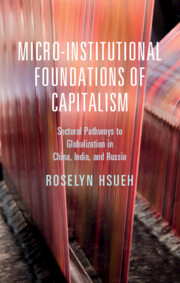Book contents
- Micro-institutional Foundations of Capitalism
- Micro-institutional Foundations of Capitalism
- Copyright page
- Dedication
- Contents
- Figures
- Tables
- Acknowledgments
- Part I Politics of Market Governance
- Part II Nations and Sectors: Patterns of Market Governance
- 3 China and Sectoral Variation
- 4 Security Imperatives, Infrastructural Development, and High-Tech Sectors
- 5 Political Stability, Local Goals, and Labor-Intensive Sectors
- 6 India and Sectoral Variation
- 7 Pro-Liberalization Transnational Business and High-Tech Services
- 8 Political Legitimacy, Economic Stability, and Labor-Intensive Small-Scale Sectors
- 9 Russia and Sectoral Variation
- 10 National Security and Infrastructure and Resource Sectors
- 11 Regional Development and Labor-Intensive Sectors
- Part III National Configurations of Sectoral Models
- Bibliography
- Index
4 - Security Imperatives, Infrastructural Development, and High-Tech Sectors
Centralized Governance in Chinese Telecommunications
from Part II - Nations and Sectors: Patterns of Market Governance
Published online by Cambridge University Press: 16 June 2022
- Micro-institutional Foundations of Capitalism
- Micro-institutional Foundations of Capitalism
- Copyright page
- Dedication
- Contents
- Figures
- Tables
- Acknowledgments
- Part I Politics of Market Governance
- Part II Nations and Sectors: Patterns of Market Governance
- 3 China and Sectoral Variation
- 4 Security Imperatives, Infrastructural Development, and High-Tech Sectors
- 5 Political Stability, Local Goals, and Labor-Intensive Sectors
- 6 India and Sectoral Variation
- 7 Pro-Liberalization Transnational Business and High-Tech Services
- 8 Political Legitimacy, Economic Stability, and Labor-Intensive Small-Scale Sectors
- 9 Russia and Sectoral Variation
- 10 National Security and Infrastructure and Resource Sectors
- 11 Regional Development and Labor-Intensive Sectors
- Part III National Configurations of Sectoral Models
- Bibliography
- Index
Summary
This chapter shows how the perceived strategic value of high-tech, value-added sectors, represented by telecommunications services and manufacturing, for national security and the national technology base, interacts with sectoral structures and organizational of institutions, and shapes the Chinese government’s centralized governance. Two decades after accession to the World Trade Organization, the Chinese government has yet to implement many of its market entry and business scope commitments in telecommunications. The state governs telecommunications with centralized coordination by a supraministry of government-owned fixed-line and mobile carriers and privately-owned but government-controlled value-added service providers and equipment makers. The dominant pattern of centralized governance enables the state to achieve its security and developmental goals even while introducing competition and exposing the industry to global economic integration. The cross-time sector and company cases uncover how reregulation and deliberate state interventions in corporate governance and anti-trust followed the market liberalization in the 1990s and 2000s. From the development of network technologies, such as 5G, to semiconductors, Chinese state-owned institutional and firm-level initiatives have strategically courted foreign direct investment and reregulated to gain corporate control or force divestment. Similarly, foreign investment and private capital have developed value-added services; but subsequent reregulation controls information dissemination and sectoral development.
Keywords
- Type
- Chapter
- Information
- Micro-institutional Foundations of Capitalism , pp. 92 - 126Publisher: Cambridge University PressPrint publication year: 2022

